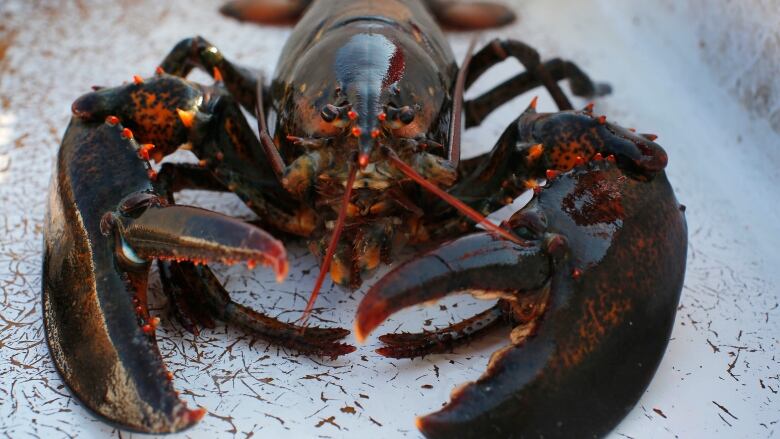Sweden still wants 'invasive species' ban on Canada-U.S. lobster
'Precautionary approach' used to justify Sweden's claim

Sweden is not backing away from its campaign to ban the import of live lobsters into the European Union, arguing a "precautionary approach" justifies its claim that the presence of North American lobsters in European waters constitutes an invasive species risk.
In late July, the Swedish agency issued its rebuttal to Canadian and U.S. scientists who have dismissed its risk assessment as unscientific, unjustified and in one instance "absurd."
"Prevention is generally more environmentally desirable and cost-effective than reaction after the fact," the Swedish Agency for Marine and Water Management said in its July 29 response.
$200Min exports at stake
A European Union committee on invasive species is expected to release an opinion by the end of August.
To protect the native European species with the scientific name Homarus gammarus the agency has applied to ban the import of Canadian and U.S. lobster Homarus americanusinto 28 European Union countries.
Live lobster exports from the U.S. and Canada are estimated at $200million a year.
In 2014, Canada exported 4,340 tonnes of live lobster to Europe, primarily to Great Britain and Belgium which is a transshipment hub.
Almost all lobsters arrive by air. The U.S. exported 8,632 tonnes.
Handful have been caught
Sweden says 32 American lobsters were captured in its waters between 2008 and 2015. Between 1999 and 2015, 29 were captured off the coast ofNorway, including twofemales carrying hybrid eggs. In Britain, 26 lobsters were caught between 1988 and 2011.
U.S. and Canadian scientists say the captured lobsterescapedfrom illegal holding facilities.
In 2015, 361 live American lobsters were released off Britain as the result of Buddhist-faith based acts, 133 have been recaptured, according to the Swedes.
DFO weighs in
Canadian objections to the Swedish application came from scientists at the Department of Fisheries and Oceans.
Like their U.S. counterparts,DFO downplayed the risk posed by the relatively few American lobster captured in European waters, noting they have been found for up to 20 years. Attempts to introduce them outside their native range on the east coast of North Americahave failed.
"In all cases there have been no signs of species establishment, let alone invasiveness," DFO stated in its June 8, 2016, review.
The Swedish Agency for Marine and Water Development acknowledged there is no "proof" American lobsters have become established.
"The occurrence of a prolonged time lag between first record and a species becoming a plague is more of a rule than an exception," the agency said in its response to DFO.
"It is necessary to bear the precautionary principle in mind when discussing risks of potential establishment ...
The fact that no successful establishment of H. americanus has been recorded so far is no guarantee that the same species will not be successfully invasive in another place or time."
Frank Stanek, spokesman for DFO, said Canadian officials have examined Sweden's position.
"It is Canada's opinion that the risk assessment does not meet the rigour required to conclude that North America's lobster could be invasive to European waters, and as such, does not merit a ban," he said.
He saidthe European Commission's Scientific Forum on Invasive Alien Species will make its recommendation on the Swedish risk assessment by Aug.31.
Swedish claim called 'absurd'
Robert Steneck, a lobster biologist from the University of Maine, was also part of the North American scientific community that evaluated the Swedish claims.
"Anything that could possibly go wrong is what is going to steer their policy," Steneck said.
Steneck said the threat is overblown.
"They are asserting this is an invasive species and there is a very clear definition of invasive species. It has to have a population that is viable, growing and actually harmful to either humans or to the environment. And there's no evidence of any of that," said Steneck.
Steneck also points to concerns expressed by the Swedish agency that barnacles found on lobster shells pose a threat to the environment. He says the same barnacles are already in European waters and are carried on the hulls of ships crossing the NorthAtlantic. Employing the same precautionary approach would ban shipping, he says.
"I think that is absurd. I don't think there is very much of a risk at all to them and that's what scientists in Canada and in the United States asserted and they had no real viable rebuttal to those assertions."
What about those hybrids
Sweden's Marine Agency agreed more study is needed to understand the impacts of interbreeding but is not willing to wait, pointing to the capture of three American lobster carrying hybrid eggs as proof that European and American lobster are breeding.
"We believe that threeout of 11, 27 per cent, is an alarmingly high ratio of hybridization, even if the total number of three females with hybrid eggs is not very high in itself," the agency said.
U.S. scientists question the viability of hybrid lobsters produced by crossbreeding.
"Hybrid larvae have been demonstrated to survive and grow in laboratory environments, however the fertility of hybrids is unclear," U.S. scientist said.












_(720p).jpg)


 OFFICIAL HD MUSIC VIDEO.jpg)
.jpg)



























































































